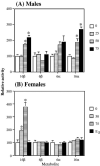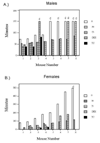Gender-specific induction of cytochrome P450s in nonylphenol-treated FVB/NJ mice
- PMID: 16828826
- PMCID: PMC1964506
- DOI: 10.1016/j.taap.2006.05.014
Gender-specific induction of cytochrome P450s in nonylphenol-treated FVB/NJ mice
Abstract
Nonylphenol (NP) is a breakdown product of nonylphenol ethoxylates, which are used in a variety of industrial, agricultural, household cleaning, and beauty products. NP is one of the most commonly found toxicants in the United States and Europe and is considered a toxicant of concern because of its long half-life. NP is an environmental estrogen that also activates the pregnane X-receptor (PXR) and in turn induces P450s. No study to date has examined the gender-specific effects of NP on hepatic P450 expression. We provided NP at 0, 50 or 75 mg/kg/day for 7 days to male and female FVB/NJ mice and compared their P450 expression profiles. Q-PCR was performed on hepatic cDNA using primers to several CYP isoforms regulated by PXR or its relative, the constitutive androstane receptor (CAR). In female mice, NP induced Cyp2b10 and Cyp2b13, and downregulated the female-specific P450s, Cyp3a41 and Cyp3a44. In contrast, male mice treated with NP showed increased expression of Cyp2a4, Cyp2b9, and Cyp2b10. Western blots confirmed induction of Cyp2b subfamily members in both males and females. Consistent with the Q-PCR data, Western blots showed dose-dependent downregulation of Cyp3a only in females and induction of Cyp2a only in males. The overall increase in female-predominant P450s in males (Cyp2a4, 2b9) and the decrease in female-predominant P450s in females (Cyp3a41, 3a44) suggest that NP is in part feminizing the P450 profile in males and masculinizing the P450 profile in females. Testosterone hydroxylation was also altered in a gender-specific manner, as testosterone 16alpha-hydroxylase activity was only induced in NP-treated males. In contrast, NP-treated females demonstrated a greater propensity for metabolizing zoxazolamine probably due to greater Cyp2b induction in females. In conclusion, NP causes gender-specific P450 induction and therefore exposure to NP may cause distinct pharmacological and toxicological effects in males compared to females.
Figures




Similar articles
-
Sexually dimorphic regulation and induction of P450s by the constitutive androstane receptor (CAR).Toxicology. 2009 Feb 4;256(1-2):53-64. doi: 10.1016/j.tox.2008.11.002. Epub 2008 Nov 11. Toxicology. 2009. PMID: 19041682 Free PMC article.
-
The environmental estrogen, nonylphenol, activates the constitutive androstane receptor.Toxicol Sci. 2007 Aug;98(2):416-26. doi: 10.1093/toxsci/kfm107. Epub 2007 May 5. Toxicol Sci. 2007. PMID: 17483497 Free PMC article.
-
Nonylphenol-mediated CYP induction is PXR-dependent: The use of humanized mice and human hepatocytes suggests that hPXR is less sensitive than mouse PXR to nonylphenol treatment.Toxicol Appl Pharmacol. 2011 May 1;252(3):259-67. doi: 10.1016/j.taap.2011.02.017. Epub 2011 Mar 2. Toxicol Appl Pharmacol. 2011. PMID: 21376070 Free PMC article.
-
Estrogen-dependent regulation of the expression of hepatic Cyp2b and 3a isoforms: assessment using aromatase-deficient mice.Toxicol Appl Pharmacol. 2002 Apr 1;180(1):1-10. doi: 10.1006/taap.2002.9366. Toxicol Appl Pharmacol. 2002. PMID: 11922772
-
The effects of gender, age, ethnicity, and liver cirrhosis on cytochrome P450 enzyme activity in human liver microsomes and inducibility in cultured human hepatocytes.Toxicol Appl Pharmacol. 2004 Sep 15;199(3):193-209. doi: 10.1016/j.taap.2004.01.010. Toxicol Appl Pharmacol. 2004. PMID: 15364537 Review.
Cited by
-
Zinc Fingers and Homeoboxes 2 (Zhx2) Regulates Sexually Dimorphic Cyp Gene Expression in the Adult Mouse Liver.Gene Expr. 2016;17(1):7-17. doi: 10.3727/105221616X691712. Epub 2016 May 17. Gene Expr. 2016. PMID: 27197076 Free PMC article.
-
HNF4α isoforms regulate the circadian balance between carbohydrate and lipid metabolism in the liver.Front Endocrinol (Lausanne). 2023 Dec 4;14:1266527. doi: 10.3389/fendo.2023.1266527. eCollection 2023. Front Endocrinol (Lausanne). 2023. PMID: 38111711 Free PMC article.
-
Repression of multiple CYP2D genes in mouse primary hepatocytes with a single siRNA construct.In Vitro Cell Dev Biol Anim. 2015 Jan;51(1):9-14. doi: 10.1007/s11626-014-9803-9. Epub 2014 Aug 15. In Vitro Cell Dev Biol Anim. 2015. PMID: 25124873 Free PMC article.
-
Increased Perfluorooctanesulfonate (PFOS) Toxicity and Accumulation Is Associated with Perturbed Prostaglandin Metabolism and Increased Organic Anion Transport Protein (OATP) Expression.Toxics. 2024 Jan 26;12(2):106. doi: 10.3390/toxics12020106. Toxics. 2024. PMID: 38393201 Free PMC article.
-
High fat diet induced obesity is mitigated in Cyp3a-null female mice.Chem Biol Interact. 2018 Jun 1;289:129-140. doi: 10.1016/j.cbi.2018.05.001. Epub 2018 May 5. Chem Biol Interact. 2018. PMID: 29738703 Free PMC article.
References
-
- Abad E, Martinez K, Planas C, Palacios O, Caixach J, Rivera J. Priority organic pollutant assessment of sludges for agricultural purposes. Chemosphere. 2005;61:1358–1369. - PubMed
-
- Acevedo R, Villanueva H, Parnell PG, Chapman LM, Gimenez T, Gray SL, Baldwin WS. The contribution of hepatic steroid metabolism to serum estradiol and estriol concentrations in nonylphenol treated MMTVneu mice and its potential effects on breast cancer incidence and latency. J. Appl. Toxicol. 2005;25:339–353. - PubMed
-
- Ahel M, Giger W, Koch M. Behaviour of alkylphenol polyethoxylate surfactants in the aquatic environment: I. Occurrence and transformation in sewage treatment. Water Res. 1994;23:1131–1142.
-
- Anakk S, Kalsotra A, Kikuta Y, Huang W, Zhang J, Staudinger JL, Moore DD, Strobel HW. CAR/PXR provide directives for Cyp3a41 gene regulation differently from Cyp3a11. Pharmacogenomics J. 2004;4:91–101. - PubMed
-
- Baldwin WS, LeBlanc GA. The anti-carcinogenic plant compound indole-3-carbinol differentially modulates P450-mediated steroid hydroxylase activities in mice. Chem.-Biol. Interact. 1992;83:155–169. - PubMed
Publication types
MeSH terms
Substances
Grants and funding
LinkOut - more resources
Full Text Sources
Other Literature Sources
Miscellaneous

